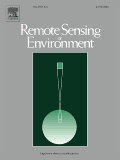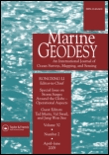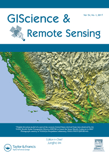
REMOTE SENSING OF ENVIRONMENT
metrics 2024
Transforming Data into Environmental Insights.
Introduction
REMOTE SENSING OF ENVIRONMENT, published by Elsevier Science Inc, is a premier academic journal specializing in the interdisciplinary field of earth observation and remote sensing technologies. With an impressive impact factor and classified in the Q1 category for Computer Science in Earth Sciences, Geology, and Soil Science as of 2023, this journal serves as a vital resource for researchers, professionals, and students alike. The journal, which has been disseminating high-quality research since its inception in 1969, provides a platform for the exploration of innovative methodologies and applications in the assessment of environmental changes and resource management through advanced imaging techniques. While not an open-access journal, REMOTE SENSING OF ENVIRONMENT offers access options that make cutting-edge research accessible to its audience. Its strategic focus on critical issues pertaining to environmental monitoring and sustainable practices underscores its role in enhancing our understanding of the planet’s dynamics.
Metrics 2024
 4.31
4.31 11.10
11.10 12.70
12.70 350
350Metrics History
Rank 2024
IF (Web Of Science)
JCI (Web Of Science)
Quartile History
Similar Journals

MARINE GEODESY
Connecting Scholars to the Heart of Marine ResearchMARINE GEODESY, an esteemed journal published by Taylor & Francis Inc, delves into the intricate field of oceanography, aiming to contribute profoundly to the understanding of marine spatial dynamics and geophysical processes. With an ISSN of 0149-0419 and an E-ISSN of 1521-060X, this journal has a commendable standing, currently classified in the 2023 Q2 quartile, reflecting its influential presence in the realm of Earth and Planetary Sciences, particularly oceanography, where it ranks 49th out of 145 journals. Since its inception in 1977 and its ongoing publication until 2024, MARINE GEODESY has been dedicated to disseminating groundbreaking research, case studies, and reviews that are crucial for scholars, professionals, and students engaged in the exploration of marine environments. While currently not an open-access journal, it nevertheless offers vital insights into marine geospatial analytics and geodesy, augmenting the knowledge base necessary for tackling contemporary challenges in marine science and geography.

Journal of Remote Sensing
Unlocking Insights through Cutting-edge Remote SensingThe Journal of Remote Sensing is a leading scholarly publication dedicated to advancing knowledge and research in the field of remote sensing. Published by the American Association for the Advancement of Science, this open-access journal, which has been available since 2021, strives to provide an inclusive platform for researchers, professionals, and students alike to share transformative findings and innovative techniques related to Earth and planetary sciences, as well as their applications in social sciences and geography. With impressive Scopus rankings, placing it in the 94th percentile for Earth and planetary sciences and the 93rd percentile in geography, the journal is recognized for its high-impact contributions to the field. Researchers can access invaluable content without barriers, ensuring that the latest advancements in remote sensing technology and methodologies are widely disseminated and utilized. By fostering interdisciplinary collaboration and promoting high-caliber research, the Journal of Remote Sensing is becoming an essential resource for anyone interested in the intersection of technology and environmental studies.

Nature Reviews Earth & Environment
Empowering Change Through Cutting-Edge ResearchNature Reviews Earth & Environment, published by SpringerNature, serves as an essential platform for researchers and professionals in the fields of environmental science, atmospheric science, and earth-surface processes. Since its inception in 2020, this distinguished journal has quickly established itself as a leading resource, achieving Q1 quartile rankings in multiple categories including Atmospheric Science and Pollution, reflecting its commitment to high-quality, impactful research. With an impressive Scopus ranking as #1 in its respective categories and a 99th percentile standing, the journal is pivotal for those seeking to explore cutting-edge advancements and critical insights in the interplay between our planet's environment and humanity. The publication encourages open discourse through its accessible content, aiming to inspire and inform its audience about pressing environmental challenges and innovative solutions. As it continues to converge through to 2024, Nature Reviews Earth & Environment stands out as a vital resource for anyone dedicated to understanding and preserving our planet.

Journal of Geovisualization and Spatial Analysis
Navigating the Future of Earth Sciences with PrecisionJournal of Geovisualization and Spatial Analysis, published by SpringerNature, is an influential open-access journal specializing in the cutting-edge fields of geovisualization, spatial analysis, and their application in earth sciences and geography. Since its inception in 2017, this journal has established a prominent stance with a high impact factor and prestigious Q1 rankings across multiple categories, including Computers in Earth Sciences, Earth and Planetary Sciences (miscellaneous), and Geography, Planning and Development. The editorial board is committed to advancing innovative research and methodologies, providing a platform for scholars to disseminate their findings globally. With impressive Scopus rankings—placing it in the top percentiles among its peers—the journal serves as a vital resource for researchers, professionals, and students keen on understanding spatial data and its implications for geographic science. Its emphasis on rigorous peer review and rapid publication enhances accessibility to substantive research, thus fostering knowledge sharing within the scientific community. Based in Switzerland, the journal promotes a collaborative environment for interdisciplinary studies, making it an essential read for anyone involved in spatial analysis research.

GIScience & Remote Sensing
Fostering Collaboration for a Deeper Understanding of Our PlanetGIScience & Remote Sensing, published by Taylor & Francis Ltd, stands as a leading journal in the realm of Earth and Planetary Sciences, holding a prestigious Q1 ranking. Since its transition to Open Access in 2022, the journal has significantly broadened its reach, enabling researchers, professionals, and students across the globe to disseminate and access cutting-edge research related to geographic information science and remote sensing technologies. With a focus on publishing high-quality, peer-reviewed articles that contribute to the understanding of the Earth’s processes, environments, and interactions, this journal not only supports advancements in scientific knowledge but also fosters interdisciplinary collaboration. Based in the United Kingdom, GIScience & Remote Sensing continues to pave the way for innovative methodologies and applications, solidifying its vital role within the scientific community.

Geomatik
Bridging disciplines with cutting-edge geospatial insights.Geomatik is a pioneering open-access journal dedicated to advancing the field of geomatics, encompassing disciplines such as geospatial data analysis, remote sensing, and geographic information systems. Founded in 2016 by the esteemed Geomatik Journal publisher, this peer-reviewed platform aims to disseminate high-quality research and innovative methodologies to a global audience. With its E-ISSN 2564-6761, Geomatik facilitates accessibility to cutting-edge studies that address vital challenges in environment monitoring, urban planning, and spatial data management. The journal not only encourages collaboration among researchers and practitioners but also serves as an essential resource for students seeking to deepen their understanding of geomatic sciences. Its commitment to open access fosters scholarly exchange and enhances visibility for authors, contributing to significant advancements within the geomatics community.

Boletim de Ciencias Geodesicas
Empowering the Geoscience Community with Open Access FindingsBoletim de Ciências Geodésicas is an esteemed academic journal published by the Universidade Federal do Paraná within its Centro Politécnico. Focused on the dynamic field of Earth and Planetary Sciences, this Open Access journal has been a pivotal resource since 1997, fostering the dissemination of critical research and innovative methodologies. With an impact factor indicative of its relevance in the discipline, Boletim de Ciências Geodésicas ranks in the Q3 quartile for Earth and Planetary Sciences as of 2023, showcasing its commitment to quality scholarship in a competitive field. Researchers and students alike will benefit from access to cutting-edge findings, given its broad scope that encompasses various aspects of geodesy and related sciences. The journal's convergence of research from 2005 to 2024 ensures that it remains at the forefront of emerging trends and fundamental developments in the discipline, further enhancing its esteemed reputation in the academic community.

South African Journal of Geomatics
Elevating the Discourse in Geographic SciencesSouth African Journal of Geomatics is a pivotal platform dedicated to the advancement of geomatics, focusing on the dynamic intersection of geographic information science, surveying, and mapping technologies. Published by CONSAS CONFERENCE, the journal serves as a crucial resource for researchers, professionals, and students in the geomatics field, providing insightful, peer-reviewed articles that explore contemporary challenges and innovations. Operating under an open-access model, the journal ensures the wide dissemination of knowledge, promoting collaboration and scholarly exchange among the global geomatics community. With a commitment to enhancing the visibility of significant research and fostering academic discourse, the South African Journal of Geomatics plays a vital role in contributing to the development of this essential discipline in South Africa and beyond.

International Journal of Image and Data Fusion
Elevating Research in Computer Science and Earth SciencesThe International Journal of Image and Data Fusion, published by TAYLOR & FRANCIS LTD, is a premier scholarly journal dedicated to the fields of computer science applications and earth and planetary sciences. With an ISSN of 1947-9832 and E-ISSN 1947-9824, this journal offers a unique platform for researchers, professionals, and students interested in the innovative integration of image processing and data fusion techniques. Operating from the United Kingdom, it plays a vital role in advancing knowledge and facilitating discussions in these rapidly developing domains, evidenced by its ranking within the Q3 category for Computer Science Applications and Q2 for Earth and Planetary Sciences in 2023. The journal features rigorous peer-reviewed content that spans from 2010 to 2024, encouraging the dissemination of novel research findings and methodologies. With a notable impact factor and strong Scopus rankings, it remains an essential resource for those seeking to enhance their understanding and application of sophisticated data fusion technologies in their academic or professional work.

European Journal of Remote Sensing
Advancing the Frontiers of Remote Sensing KnowledgeThe European Journal of Remote Sensing, published by Taylor & Francis Ltd, stands as a pivotal resource in the domains of applied mathematics, atmospheric science, and earth sciences. Since its transition to Open Access in 2012, the journal has facilitated unrestricted knowledge dissemination, fostering collaboration and innovation among researchers. With a notable impact factor reflected in its quartile rankings—achieving Q2 in applied mathematics and atmospheric science, and Q1 in miscellaneous environmental science—the journal is a respected platform for high-quality research. Based in the United Kingdom, it encompasses a wide range of topics related to remote sensing technologies and their application in environmental monitoring. Researchers and professionals in these fields will find the journal indispensable for its commitment to advancing scientific understanding and promoting the use of remote sensing methodologies in tackling contemporary environmental challenges.